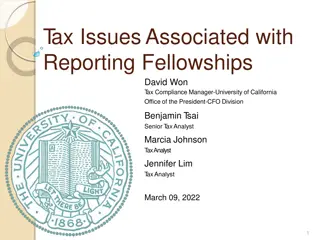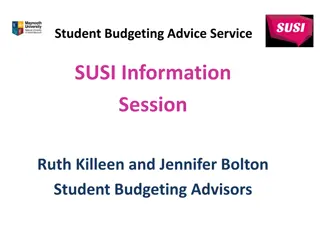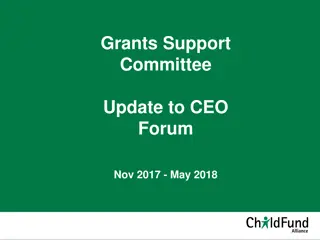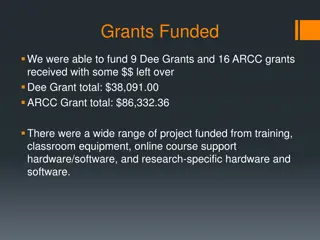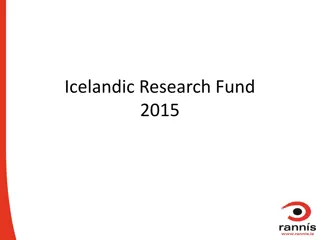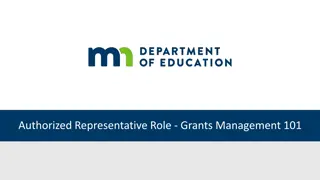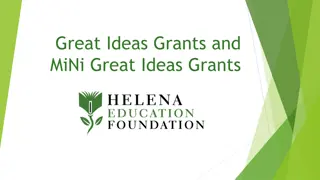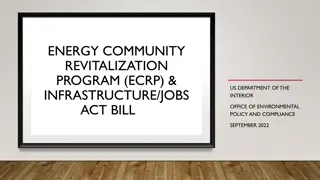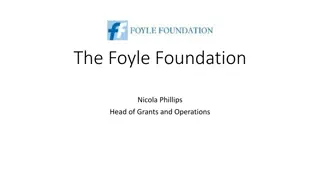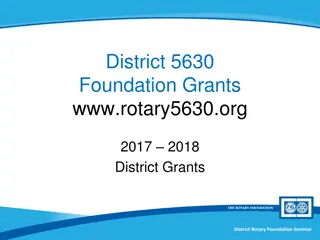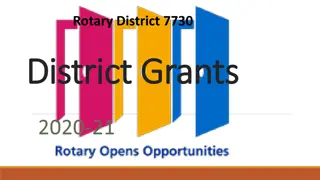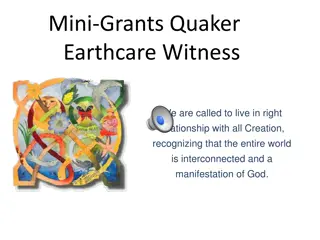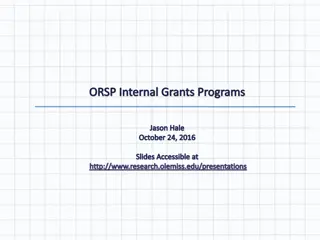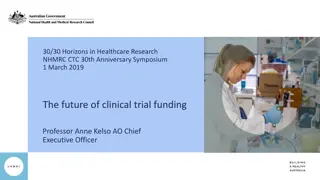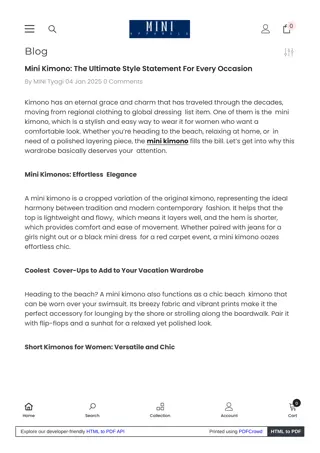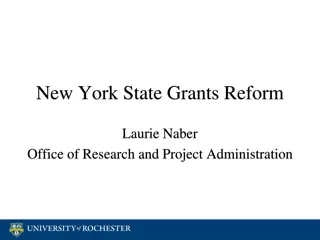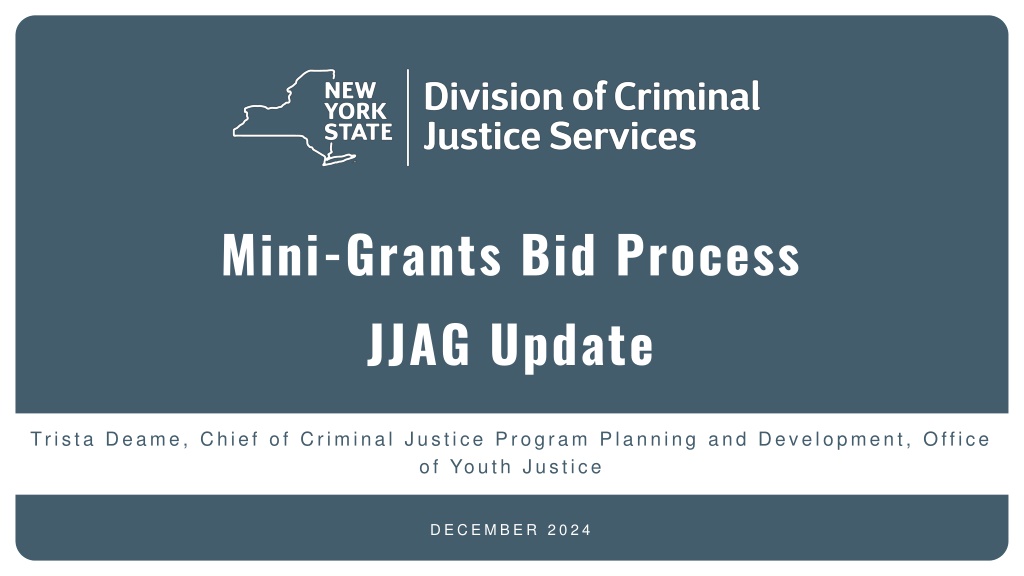
Criminal Justice Program Mini-Grants Bid Process Update 2024
Explore the 2024 Mini-Grants Bid Process Update for the Criminal Justice Program, including timelines, application instructions, work plan templates, budget details, and more to support youth justice initiatives. Learn about allowable costs, objectives, and desired outcomes to reduce detention disparities among youth of color.
Download Presentation

Please find below an Image/Link to download the presentation.
The content on the website is provided AS IS for your information and personal use only. It may not be sold, licensed, or shared on other websites without obtaining consent from the author. Download presentation by click this link. If you encounter any issues during the download, it is possible that the publisher has removed the file from their server.
E N D
Presentation Transcript
Mini-Grants Bid Process JJAG Update Trista Deame, Chief of Criminal Justice Program Planning and Development, Office of Youth Justice D E C E M B E R 2 0 2 4
Mini-Grants Bid Process Timeline: 2024 JJAG Approve Funding Proposal Bid Grantees Notified Request Closed Nov 12th Oct 16th June 18th Sept 16th Dec Bid Grantees Selected Request Made Live 3 DIVISION OF CRIMINAL JUSTICE SERVICES
Mini-Grant Application: Instructions To complete your application, please provide a detailed work plan and budget. All funding provided must support program efforts during the project period. Funding requests not directly related to the work plan will not be granted. Allowable Costs: Examples of allow able program categories for funding include, but are not limited to the following: Mentoring Mental health services Restorative practices Trauma and healing Positive youth development opportunities Community trust building Personnel and administrative overhead are also examples of allowable costs. Examples of unallowable categories for funding include, but are not limited to, the following: Capital improvement projects Law enforcement equipment 4 DIVISION OF CRIMINAL JUSTICE SERVICES
Mini-Grant Application: Workplan Workplan Template Goal #1 (What do you want to achieve): Reduce the number of youth of color placed in detention. Why is this a priority? 2015 data show that youth of color represent 25% of total referrals to intake but 60% of youth detained at that point. Objectives (How will you achieve the Goal): Implement an objective detention risk assessment instrument (RAI). Desired Outcomes (What results do we expect?): Reduced overrepresentation of youth of color in detention admissions. Action Steps Task Responsible Party RAI Subcommittee (John Smith as lead) Target Date 2/1/2016 Notes Circulate draft instrument one week before committee s meeting on 2/7/16. 1.Complete a draft RAI for committee s review 2. 3. 4. 5 DIVISION OF CRIMINAL JUSTICE SERVICES
Mini-Grant Application: Budget Organization Name Assumptions Award Amount - Indirect Rate - 10% of Direct Costs Fringe Rate - 23% DCJS GMS Project ID: *Indirect Costs: are capped at 10% *Fringe Benefits includes things such as Employer Sponsored Healthcare Position Name Salary Total Budget Total Salaries - - - Total Fringe - Total Personnel - Consultants Total Consultants - Equipment Total Equipment - Supplies Total Operating Expenses/Supplies - Travel Total Travel - All Other Total All Other - Total Direct Costs - Indirect Costs - Totals - 6 DIVISION OF CRIMINAL JUSTICE SERVICES
Mini-Grant Bid Response Results To evaluate the quality and completeness of the applications received, a scoring instrument was developed to capture organizational experience, completeness and comprehensiveness of the workplan submitted and program proposed as well as, the appropriateness of budget submitted to support the work. A pre-scoring meeting was held with reviewers to go over the intent of the bid request, the requirements for submission, as well as the scoring instrument and consistency in making scoring decisions. A total of five individuals who scored each application, the average score of each application was utilized in the decision-making process. Below is a quantitative summary of the received responses. Total Number of Bids Received: 82 Total Number of Bids Disqualified in Initial Review: 24 Total Number of Bids Reviewed and Scored: 58 Reviewers included: Trista Deame, Alison Floyd, Courtney Murphy, and Omar Cyrille from OYJ; and Tonya Tamir from OPDF. Responses were automatically disqualified if organizations were not pre-qualified in the State Financial System. 7 DIVISION OF CRIMINAL JUSTICE SERVICES
Mini-Grant Bid Response Results: Applied Geographic Locations NYC 20 applicants ROS 38 applicants Murphy, and Omar Cyrille from OYJ; and Tonya Tamir from OPDF. Responses were automatically disqualified if organizations were not pre-qualified in the State Financial System. 8 DIVISION OF CRIMINAL JUSTICE SERVICES
Mini-Grant Bid Response Results: Selected Geographic Locations NYC 6 grantees ROS 9 grantees Murphy, and Omar Cyrille from OYJ; and Tonya Tamir from OPDF. Responses were automatically disqualified if organizations were not pre-qualified in the State Financial System. 9 DIVISION OF CRIMINAL JUSTICE SERVICES
Mini-Grant Bid Response Results: Funded Programmatic Areas Trauma, healing, and mental health services Network of Peer Workgroups for justice involved youth and their caregivers Restorative Justice and Restorative Practices Family and Community Centered Prevention Programs; artivism, listening circles, and community engagement Reviewers included: Trista Deame, Alison Floyd, Courtney Murphy, and Omar Cyrille from OYJ; and Tonya Tamir from OPDF. Responses were automatically disqualified if organizations were not pre-qualified in the State Financial System. Credible Messenger School-based Programming; increased literacy and decrease in disciplinary incidents and reduce chronic and severe absenteeism amongst youth of color SEL and RJ in facilitates Community-trust building and healing Culturally competent and dual language speaking mentors and therapists Positive Youth Development Opportunities 10 DIVISION OF CRIMINAL JUSTICE SERVICES


